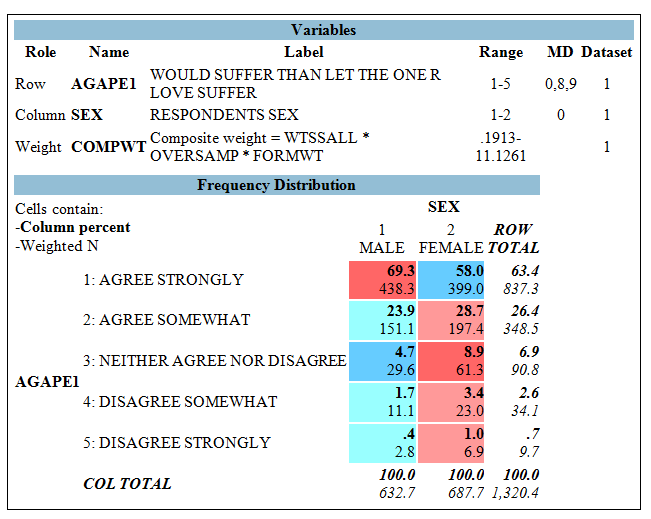The 69.3 in the upper left hand of the cross-tab in Figure 3.1shows that:
The variable AGAPE1 records respondents’ answers to the following question “Do you agree strongly, agree somewhat, neither agree nor disagree, disagree somewhat, or strongly disagree with the following statement? I would rather suffer myself than let the one I love suffer.
Figure 3.1

a. 69.3% of respondents strongly agreed with the statement “I would rather suffer myself than let the one I love suffer.”
b. 69.3% of men strongly agreed with the statement “I would rather suffer myself than let the one I love suffer.”
c. 69.3% of the people who strongly agreed with the statement “I would rather suffer myself than let the one I love suffer” were men.
d. About 69 men strongly agreed with the statement “I would rather suffer myself than let the one I love suffer.”
b. 69.3% of men strongly agreed with the statement “I would rather suffer myself than let the one I love suffer.”
You might also like to view...
Are the units about which information is collected and are the units from which information is collected
a. Units of observation; units of analysis b. Units of analysis; units of observation c. qualitative units; quantitative units d. quantitative units; qualitative units e. none of these
A church in the sociological sense is essentially the same thing as a denomination
Indicate whether the statement is true or false
Explain how social movements can influence definitions of deviance using a recent movement, such as Black Lives Matter or the #MeToo movement.
What will be an ideal response?
The efforts of disability rights activists to remove the stigma attached to disabilities demonstrate how the definition of normal versus abnormal depends upon
A. the degree of abnormality. B. cultural definition. C. how individuals feel. D. the nature of the affliction.